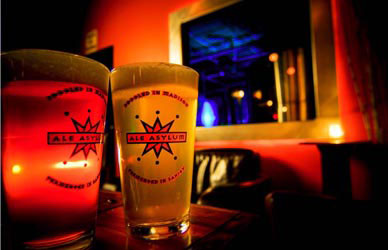

Multimedia
Click here to see a map of the microbreweries in Wisconsin
Links
The Tale Behind the Ale
Small Wisconsin breweries deliver big flavors
When craft brewer Otto Dilba talks about beer, he thinks of meat. He doesn’t hesitate to distinguish himself from refrigerated-case, name-brand, cheap lunchmeat. "You purchase Oscar Mayer bologna, and you're enjoying the heck out of it," Dilba says. "Then one day you step to the deli and you say, 'I want to try some of that ham,' and you like it. It's a little more expensive, but it's really flavorful; it's really enjoyable.”
The same applies to his beer. Dilba, owner of Ale Asylum craft brewery in Madison, knows he's delicatessen, not bologna. And while he knows Oscar Mayer has its place, he feels craft brews – with their slightly higher price and mightily more distinctive taste – carve out a niche from the big boys. Microbrews will never own the market, but they continue to capture drinkers who Dilba says one day opt to "try some of that."
Microbreweries and brewpubs have wedged their way into a recognizable spot in the brewing industry circle. Even in a slowing economy, many of these small establishments are enjoying success. Craft brewing is a $5.7 billion industry, and the Brewers Association reported United States’ craft beer sales increased 11 percent in the first half of 2008 compared to the same period in 2007.
Tom Volke, a member of the Master Brewers Association of the Americas, believes microbreweries’ variety and special relationship with the community give them an edge over the bigger companies. “[Microbreweries] have some camaraderie with the locality,” says Volke, who serves as MBAA treasurer of the Milwaukee district. “It makes these places unique, because they are owned and operated by people in the community.”
Smaller in size, microbreweries can experiment with more varieties and flavors of beer. Brewer Russ Klisch enjoys the challenge of coming up with new beers each season. His creativity does not falter – Lakefront Brewery in Milwaukee boasts five ales, three lagers and eight seasonal beers. Volke adds a smaller demand allots more time for brewers to tailor their flavors for the market.
Dilba notes buying beer from a microbrewery supports the local economy. According to Dilba, staying local can even give brewing advantages, because bigger companies tend to brew “mass-produced, watered-down” beer. “They’re not really looking to make close to what we offer or craft beers that we offer,” Dilba says. “Our beers are going to have more flavor, more robust, more body to it.”
In an industry changed by the merge of the large breweries Miller and Coors, craft breweries continue to hold their own with the big ones. Staying creative and offering different products allow these small breweries to thrive.
Milwaukee’s Lakefront Brewery – which in 1996 brewed the first certified-organic beer labeled in the United States – is also working to create a cooperative with other breweries and Wisconsin hops farmers to keep products local. Volke, however, says it is currently too costly to use Wisconsin hops farmers alone. But Klisch is optimistic to join smaller breweries in the organic movement.
“We’re trying to bring the hops crop back to Wisconsin,” Klisch says. “You can’t compete with the corporate farms in the nonorganic business.”
Home I Mind I Body I Soul I Site Map
About Us I Contact Us I Business Partners I Archives
Copyright 2008 Curb Magazine